My introduction to Arthurian legend came at the ripe age of 14 when I first read The Mists of Avalon by Marion Zimmer Bradley. The cryptic but beautiful descriptions of the magic that the priestesses of the Mother Goddess wield transported me to Avalon. Morgaine was the first character of her kind I was exposed to, powerful but flawed, and of course I was also entertained by the doomed love triangle of Arthur, Lancelet, and fair Gwenhwyfar.
But perhaps most impactful were the revelations of religious persecution provided by Bradley’s moving (and historically accurate) narrative of how Christianity sought to crush the Pagans and erase them from the world in favor of their God. Putting this book on a list of ones that changed my worldview, for better or worse, and it remains an all-time favorite.
Since then I have been an enthusiastic consumer of Arthurian literature. My current read, The Lost Queen by Signe Pike, is another feminine take on this world of legend, following Merlin’s twin sister as she grapples with an unfair fate and her role in preserving her people’s way of life. This book reignited my interest in the legends, and sent me down a rabbit hole of research to understand the origination of these tales that have captivated our imaginations for so long.
For many years I thought that King Arthur was a historical figure. An actual man who existed in the late 5th and early 6th centuries, a courageous leader who defended Britain from Saxon invaders. I eventually came to learn that no, he was not in fact a real person, or at least historians are not able to confirm that he was. But it’s a debate that has raged for literally centuries, with seemingly no end in sight when you consider the burden of proof being nearly impossible to overcome.
Here are the Cliff's Notes of what we know (because the twists, and turns, and dead ends in the known history of this legend exist in great numbers): There is only one surviving firsthand source of the Saxon invasion, written by a Celtic monk named Gildas around 500 A.D. This work is said to be the milieu from which Arthur was born, but strangely Arthur does not appear by name in this or anything else for several hundred more years. Gildas reportedly had an annoying penchant for vagueness. Arthur made his official debut in the writings of a Welsh historian named Nennius, who made a list of no less than 12 battles King Arthur fought and won. However, the battles were so scattered over land and time that it is not possible for one man to have been present for all of them.
In 1136, Geoffrey of Monmouth penned The History of the Kings of Britain, in which the first complete life story of King Arthur unfurled. Monmouth claimed that he simply translated an ancient book given to him by his friend and colleague, a British cleric and writer, Walter of Oxford. Most modern historians agree that this is “fake news” (even Monmouth's colleagues at the time were dubious) and most agree that Geoffrey of Monmouth took bits and pieces from several earlier works on the Kings of Briton, smoothed them out, embellished them, and thus completely contrived the story of King Arthur.
Fictitious or not, once this fairly comprehensive groundwork was laid, poets and writers of the age were off. The next to pick up the mantle was Robert Wace of Normandy, who is credited with naming Excalibur. Then came the poet Chretien de Troyes who invented the story of Lancelot and Guinevere, two of the most enduring characters of Arthurian literature. Then Robert de Boron gave life to the legend of the sword in the stone, and so on and so forth for centuries. French, German, and English writers added to the story in bits and pieces. Perhaps most notable was Thomas Malory’s English prose masterpiece, Le Morte D'Arthur. This was published in 1485 by William Caxton as part of his effort to introduce the miracle of the printing press to England.
Very recently, seven handwritten fragments featuring King Arthur and Merlin were discovered by a special collections librarian at the University of Bristol. Scholars believe there is a chance these pieces could be part of what inspired Le Morte D'Arthur. You can read more about this discovery here.
Eventually, the theme fell out of favor. Artists and consumers of the Renaissance viewed Arthurian legend as old hat, and it wasn’t until Tennyson’s Idylls of the King that it was revived. Since then, we have seen some of the brightest literary minds take on the challenge, including T.H. White (author of The Once and Future King, probably the most well-known story of Arthur), John Steinbeck, Bernard Cornwell, and even J.R.R. Tolkien. So whether you are new to the lore, or an old fan like myself, the past is chock full of great works, and the future of Arthurian legend is looking pretty bright as well.
Which brings me to the statue of King Arthur at the ruins of Tintagel, which is where Geoffrey of Monmouth alleged King Arthur was conceived by Uther Pendragon and Igraine. It's so profoundly perfect in my eyes. Firstly, it's a breathtaking piece of art, but it's also so symbolic. A stoic and tattered king, born of a time and place that needed a hero and given life, piece by piece, by the generations that followed...but with plenty of room to grow.
-Leah Newton is a Readers' Services Assistant at Lawrence Public Library.



Add a comment to: Arthurian Legend: Then, Now, and Forever